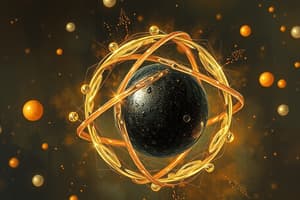Podcast
Questions and Answers
What happens when you look through a red cellophane?
What happens when you look through a red cellophane?
- Everything appears transparent
- Everything appears in a shade of blue
- Everything appears in a shade of green
- Everything appears in a shade of red (correct)
What type of light does a green cellophane allow to pass through?
What type of light does a green cellophane allow to pass through?
- Red light only
- Blue light only
- Green light only (correct)
- All colors of light
What does it mean that red cellophane absorbs other colors of light?
What does it mean that red cellophane absorbs other colors of light?
- It reflects other colors of light
- It emits other colors of light
- It allows other colors of light to pass through
- It stops other colors of light from passing through (correct)
Why won't red light pass through a green cellophane?
Why won't red light pass through a green cellophane?
What is the general rule regarding color filters like glass or cellophane?
What is the general rule regarding color filters like glass or cellophane?
If you look through a blue cellophane, how will things appear?
If you look through a blue cellophane, how will things appear?
Why does a green object appear black when viewed through a red cellophane?
Why does a green object appear black when viewed through a red cellophane?
What would happen if you view an orange object through a blue cellophane?
What would happen if you view an orange object through a blue cellophane?
Why does a yellow object appear as its true color when viewed through a yellow cellophane?
Why does a yellow object appear as its true color when viewed through a yellow cellophane?
What is the reason behind why some objects appear black when viewed through certain color filters?
What is the reason behind why some objects appear black when viewed through certain color filters?
Flashcards are hidden until you start studying
Study Notes
Optical Phenomena
- Optical phenomena are observable events resulting from the interaction of light with matter.
Rayleigh Scattering
- The blue color of the sky and the red color of sunsets are due to Rayleigh scattering.
- Gases and suspended dust particles in the atmosphere scatter shorter wavelengths of visible light (violet and blue) more than longer wavelengths (red).
- Our eyes are more sensitive to blue light, making the sky appear blue.
Color of the Sun
- The sun appears yellow during midday due to the direct passage of dominant amounts of yellow frequency.
- As the sun approaches the horizon, it becomes red due to the scattering of red light, the lowest frequency in the spectrum.
Clouds and Rain Clouds
- Water droplets in clouds are of similar size as the wavelength of sunlight, scattering all visible light and appearing white (Mie scattering).
- Rain clouds are dark due to their thickness and height, blocking sunlight and giving a gray color.
Rainbows, Halos, and Sun Dogs
- Rainbows are optical illusions, dependent on the position of the observer and the sun.
- Light is refracted as it enters the surface of a raindrop, creating the colors of the rainbow.
Mirages
- Inferior mirage: light bends upward due to warm air near the ground, creating an inverted image below the upright one.
- Superior mirage: light bends upward due to cold air near the ground, creating an inverted image above the upright one.
Light and Colors
- Artificial light has a different mixture of wavelengths than sunlight, affecting how colors appear.
- Incandescent bulbs heighten warm colors, fluorescent bulbs intensify blue and green, and CFLs produce a warm, neutral, or bluish light.
- LEDs have cooler or warmer lights, and "smart" LED bulbs can be controlled.
Sunlight and Room Lighting
- Sunlight changes throughout the day and is affected by a room's location.
- East-facing rooms have warm and yellow light before noon, bluish later in the afternoon.
- West-facing rooms produce shadows and make colors look dull.
- South-facing rooms bring out the best in cool and warm colors.
- North-facing rooms have cool and bluish light.
Color Filters
- Cellophane is a transparent material that changes the color of what is seen through it.
- Each color filter (e.g., red or green cellophane) allows only light of its own color to pass through and absorbs other colors.
Studying That Suits You
Use AI to generate personalized quizzes and flashcards to suit your learning preferences.




